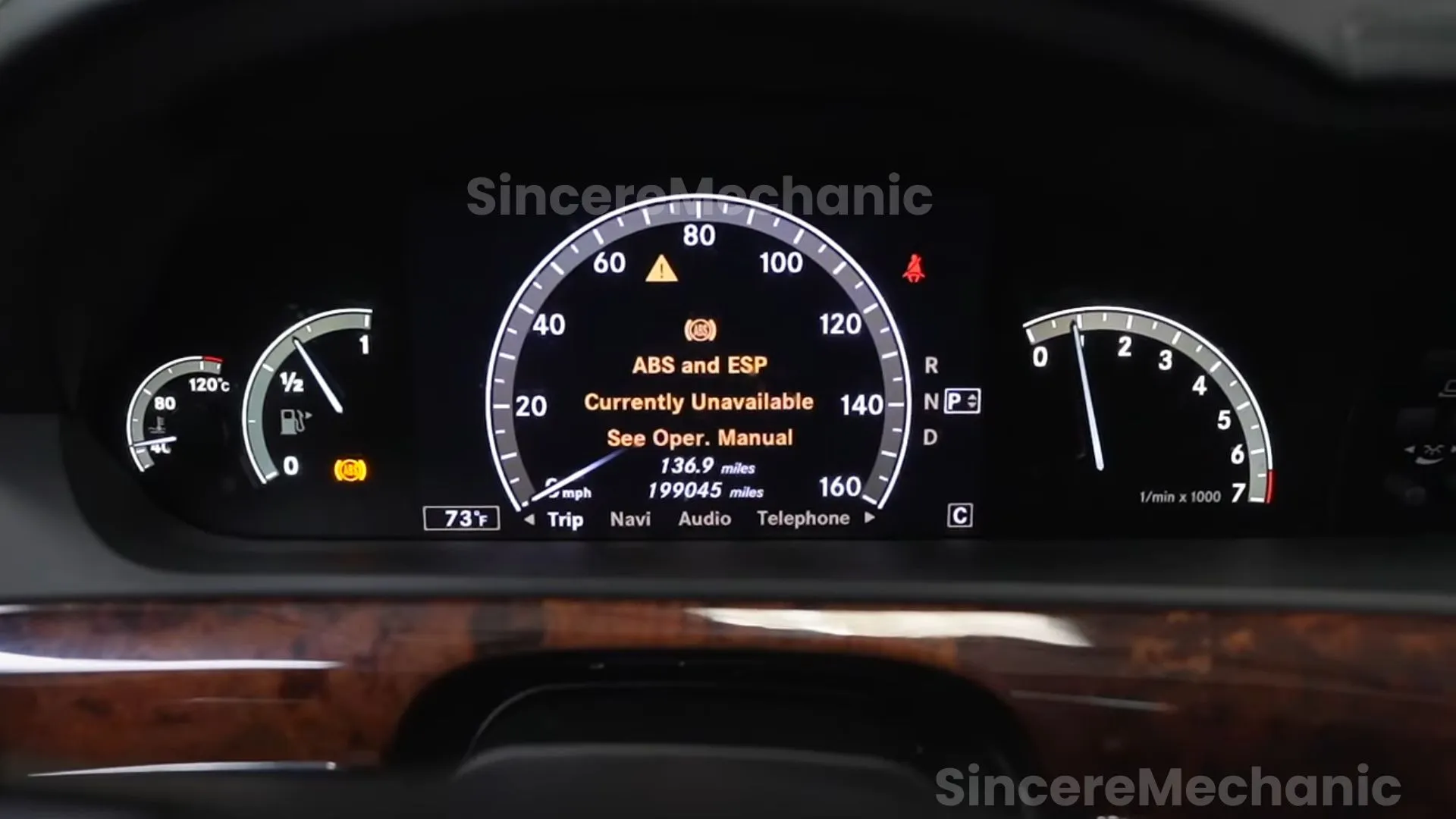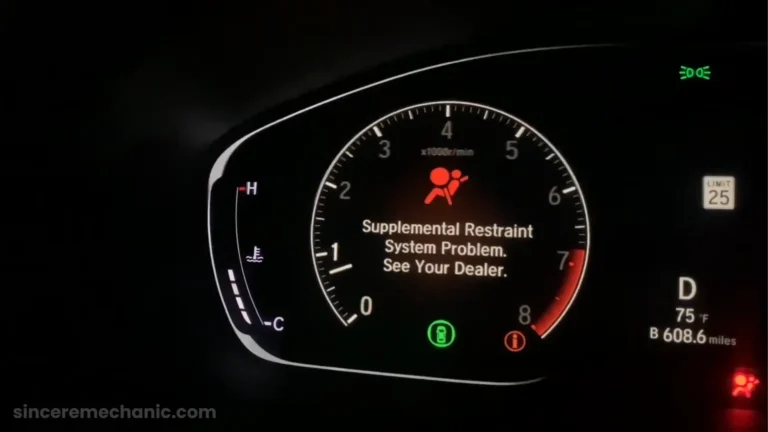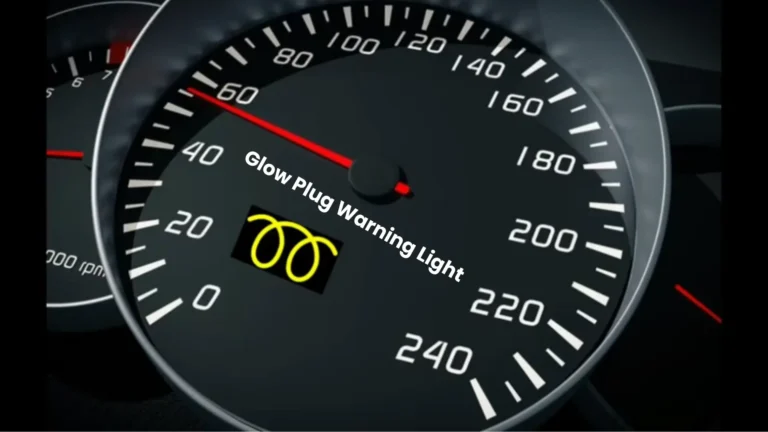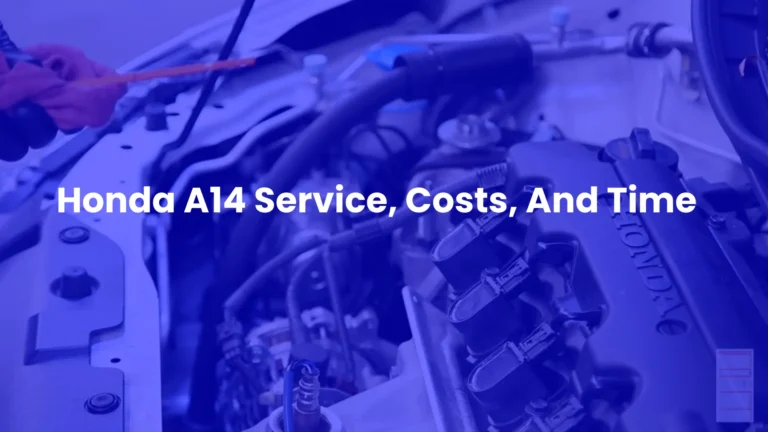Mercedes-Benz ESP Inoperative Warning & Causes: [Explained]

Are you facing a Mercedes-Benz ESP Inoperative Warning? Then don’t worry. You’ve landed at the right place. In this article, I’ll explain the causes, how to fix it, and all other necessary information you need to know about that warning light.
Mercedes-Benz ESP® warning is one of the ways that vehicles need ways to communicate with you. This warning message presents itself and provides a solution to enhance driving confidence.
It doesn’t matter if you drive an S-Class, C-Class, E-Class, GL-Class, or any other Mercedes-Benz model. This solution is the same for all Mercedes vehicles.
What Does Mercedes-Benz ESP Inoperative Mean?
Many advanced technology systems are built into Mercedes Vehicles to enhance the driving experience. ESP® is one of these and stands for “Electronic Stability Program.”
The real purpose of ESP® is to stabilize your vehicle and keep it on in a planned direction by keeping all four wheels planted. During critical situations, it maintains control of the car.
Therefore, it is essential to solve this problem when the Mercedes-Benz ESP® Inoperative Warning light appears on your vehicle’s dash.
How Does ESP® Work In Mercedes-Benz?
ESP® prevents the vehicle from a skidding tire or wheel spin, fundamentally losing tire traction. Several other factors, like stability losses, contribute to that, and ESP® uses many systems to correct these factors and provide protection.
The first thing it uses is ABS (anti-locking braking system). If you’ve been driving for years, you know that slamming brakes gives a little usable stopping force. ABS counters this, preventing wheels from locking by the pulsing of the brakes.
ESP® makes accurate adjustments hundreds of times (per second) by using data such as wheel speed and tire pressure.
The best thing is it automatically controls each wheel’s speed by retrieving the vehicle’s control and stability. ESP® helps a lot when your car’s tires must be replaced soon.
![Mercedes-Benz ESP Inoperative Warning & Causes: [Explained] 1 Mercedes-Benz ESP reset & fix](https://sinceremechanic.com/wp-content/uploads/2024/03/Mercedes-Benz-ESP-reset-fix--1024x576.webp)
What Causes ABS And Mercedes ESP® Inoperative Message?
To Fix this message, it’s imperative to know the cause of it. Here are the most common problems that can be the reason behind ABS and ESP® inoperative error messages:
- Damaged or spoil ABS Wheel Speed Sensor
- Weak or dead 12-volt battery
- Bad alternate or voltage regulator
- If the Steering Angle Sensor needs calibration or replacement
Also Read: Mercedes Pre-Safe Functions Limited
What Is Calibration?
According to the facts, different primary processes can be performed to maintain the instrument’s accuracy. Instrument calibration is one of these. It is a procedure to configure an instrument to deliver the result within an acceptable range for a sample.
What Is Alternator?
The alternator looks like a small cylindrical generator, saturated to bolted to your vehicle’s engine. Three main parts are in the electric charging system of a vehicle: A car alternator, battery, and voltage regulator.
An alternator supplies electricity to be stored in the battery. It also converts mechanical power from a serpentine or driver belt into electricity.
All brake assistance systems, like ESC, ABS, and EBR, are detailed systems in vehicles. They’ve many sensitive sensors and other components.
![Mercedes-Benz ESP Inoperative Warning & Causes: [Explained] 2 Mercedes ESP Inoperative](https://sinceremechanic.com/wp-content/uploads/2024/03/Mercedes-ESP-Inoperative-1024x576.webp)
A sensor in damaged or malfunctioning condition could bring many issues in a vehicle. These issues can be the reason for multiple systems down and also affect the stability and performance of the vehicle braking mechanism.
There are multiple potential causes for Mercedes-Benz ESP Inoperative & ABS messages. Here are some common among these:
- A damaged battery or faulty alternator can reduce the optimal performance and may affect the ESP operation. The reason is that all sensors and other components need a steady voltage. Even the slightest change or irregularity might affect them and can offset their function.
- A brake light system is another system that all cars have. As it shows from its name, when the vehicle slows down, it illuminates the brake lights. When a driver presses the brake pedal, ESP systems use this signal to recognize that activity, and the ABS recognizes these faulty signals and shuts down the system as a preventive action.
- The wheel speed sensors, wiring, and other essential components are likely to fail due to dirt and corrosion. Because of this action, they will give inaccurate readings. Those readings will confuse the ABS factor or create a problem.
- Faulty solenoids or worn hydraulic valves are also possible causes of those messages. The transmission will not shift at neutral because the faulty solenoid will not receive the proper signals that would be enough to change the transmission. On the other hand, worn hydraulic values would hurt the compression process.
- Other reasons ESP warning lights appear on the dashboard are corrupted software, faulty connectors, low tire pressure, bald tires, and incorrect wheel alignment.
How Do You Reset Mercedes-Benz ESP Warning Light?
A reset can be pretty simple if the Mercedes-Benz ESP Inoperative warning is still displayed. The process will modify for different models but will usually be as mentioned:
- Find the “ESP® Off” button on the dash.
- Push and hold the button for just five seconds.
Here is a question that arises in your mind. What do I’ve to do if my vehicle doesn’t have an “ESP® Off” button or this process doesn’t work for any reason?
In those circumstances, you can take a trip with an authorized Mercedes service center where the technician will make a proper diagnosis of malfunctions that your vehicle is facing. They have different scanners (like OBD-II ) for troubleshooting and bi-directional tests for maintenance.
To get service cost-effectively, ask for coupons if they are available. By practicing this, you can make the process comfortable for your wallet.
Conclusion
It is the goodness of a responsible vehicle owner to maintain the overall vehicle properly. ESP light comes on for some reason, so take time to address the Mercedes-Benz ESP Inoperative Warnings, but don’t be late to get them fixed.
You can diagnose and resolve issues precisely by following the facts & figures and expert guidance in this extensive guide. This step will ensure an efficient, smooth, and safe driving experience.
Your Mercedes-Benz deserves the best care in every aspect. So, suppose you’re confused by any point we’ve discussed or are sitting on the fence about what to do. In that case, It would be better to seek assistance from some professional or visit your nearest reputable reparing center.
Frequently Asked Questions By Drivers
Martin Lee is an ASE-certified mechanic and contributing author at SincereMechanic. He uses his expertise to create captivating articles that align with our content strategy. Using his deep automobile knowledge, he does in-depth research, puts expertise into articles, and makes them very informative. That information ensures our readers receive many valuable insights about the Vehicles.




